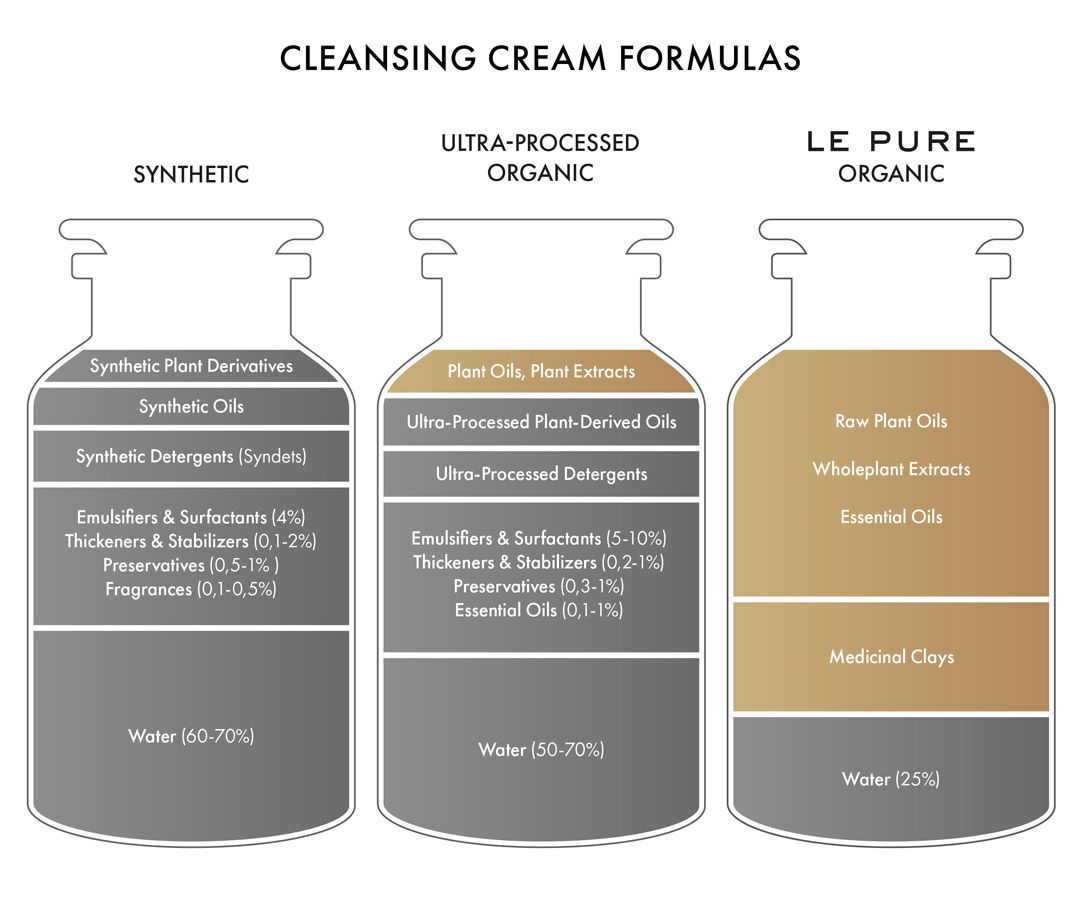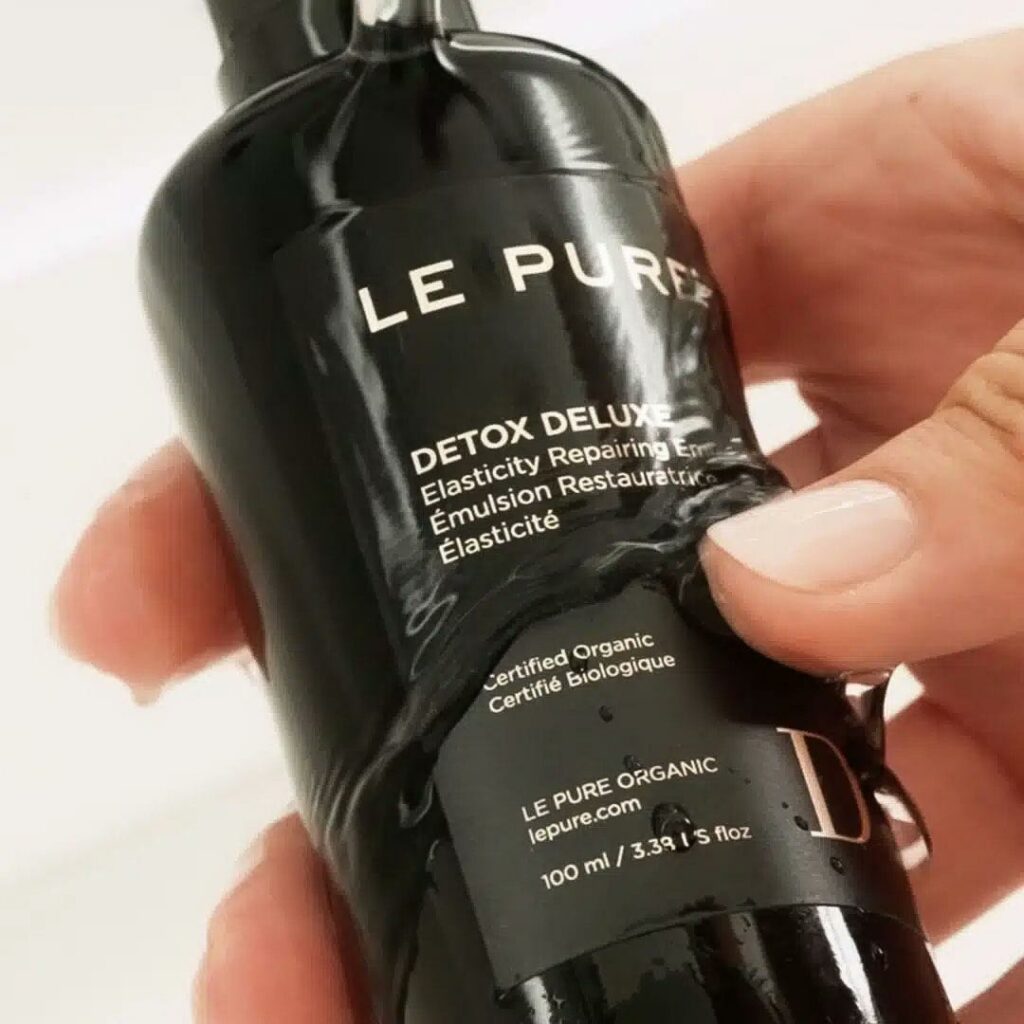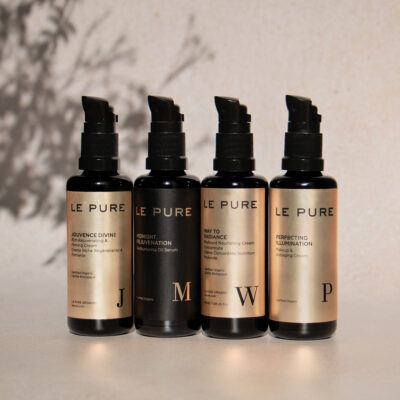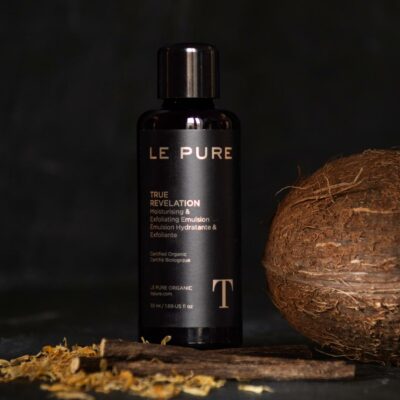The Skin’s Microbiome and Acid Mantle: A Powerful Ecosystem
Many people have heard about the importance of the microbiome of the gut, but few know about the skin’s microbiome, which is crucial to healthy and youthful skin. The microbiome, together with the acid mantle of the skin, forms a complex ecosystem that is key to maintaining the moisture and elasticity of the skin.
The microbiome, sometimes also called the skin flora, supports the growth of many microorganisms. Together with the skin’s own fat and sweat, they create an acidic environment that is hostile to pathogens and prevents them from settling on or trespassing the skin surfacing.
While the delicate balance of this ecosystem is maintained, the skin barrier optimally protects the skin.

What is the human skin microbiome and ecosystem
The influence of the microbiome on skin’s aging
How to cleanse the skin without damaging its ecosystem
Ingredients that strengthen and protect the skin’s microbiome
Cleansing ingredients that debilitate the skin’s microbiome
The ideal organic face wash with LE PURE
What is the human skin microbiome and ecosystem
The skin’s microbiome consists of living components such as human skin cells but also a community of mainly bacteria and some viruses, fungi, and mites.
The nonliving components include lipids, salt, and cellular debris. This ecosystem has an acidic, humid, and low-temperature environment.

The influence of the microbiome on skin’s aging
Any imbalance of the beneficial bacteria on the skin or a lack of skin fat on the surface can lead to a change in acidity and protection. The result is a damaged acid mantle, which enables harmful bacteria to enter the skin, causing skin alterations and moisture loss.
The continued imbalance of the skin’s protective ecosystem can also negatively impact crucial functions such as optimal cell regeneration, skin metabolism, and self-defense mechanisms against free radicals. Not only incorrect cleansing has a detrimental effect on the skin’s protective barrier, but also excessive peelings and acid treatments alter the natural balance of the microbiome and the hydrolipidic film. Over time, an alteration of the skin’s protective ecosystem can lead to premature skin aging.
How to cleanse the skin without damaging its ecosystem
The skin constantly purifies itself by eliminating dead skin cells as well as metabolic residues and dirt thanks to various bioenzymes. However, as our skin is often exposed to environmental dirt, pollution, and makeup, water alone is not enough to remove dirt from the skin’s protective barrier, which is also called the hydrolipidic film.
Natural as well as synthetic soap have a negative impact on the microbiome of the skin and their application on the face should be avoided.
They remove the natural skin fat, alter the pH of the skin, and deposit residues on the hydrolipidic film.
Ingredients that strengthen and protect the skin’s microbiome
In order to strengthen and protect the skin’s barrier, we need to cleanse with ingredients that are compatible with our skin microbiome: cold-pressed oils, medicinal clays, wholeplant extracts and essential oils.
These ingredients, together with the ideal cleansing technique, remove dirt, pollution, and makeup without stripping the natural skin fat and beneficial microorganisms from the skin’s surface.

Examples of beneficial cleansing substances:
Look for ingredients with Latin plant names on the label. The use of the Latin name of the plant indicates the ingredient has been only minimally transformed by physical or mechanical processing such as a cold pressing of an oil.
Cold-pressed plant oils: Helianthus Annuus (Sunflower) seed oil, Persea gratissima (Avocado) oil
Clays: Kaolin, Hectorite
Wholeplant extracts: Saponaria officinalis (Soapwort) leaf / root extract, Tabebuia impetiginosa (Lapacho) bark extract, Rosa centifolia (Rose) flower extract, etc.
Essential oils: Lavender, Pelargonium, etc.
The only disadvantage of these ingredients in cleansers is that they are not widely available on the market, and their natural origin and high concentrations in the formula result in a higher product price. A cleanser with 75% of the highest quality plant ingredients and medicinal clays is far more expensive than a conventional cleanser that contains 80% water and industrial chemicals.
Investing in a premium organic cleanser is a key part of a successful antiaging skincare routine. A healthy skin barrier maintains the skin elastic and enables optimal cell regeneration.
With an adequate protective barrier, the skin needs fewer creams and serums as it will be able to regulate important skin functions by itself.
The manual application of these beneficial cleansing ingredients is also of utmost importance. The ideal antiaging cleansing ritual includes profound yet gentle movements that stimulate collagen and elastin production, while they stimulate lymphatic drainage. We recommend applying a high-quality facial cleanser with filtered water since hard (calcareous) or chlorous water has a negative impact on the acid mantle.

Cleansing ingredients that debilitate the skin’s microbiome
Due to the lack of knowledge about the skin’s ecosystem, there are many cleansing products on the market that contain ingredients that can interfere with the delicate balance of this complex microbial protective layer. Natural as well as synthetic soaps are not compatible with the skin’s microbiome.
The application of natural soap or synthetic detergents on the skin forces the elimination of dirt with detergent elements that affect the nerve sensitivity of the skin and provoke an aggravation of any underlying skin problem.
Detergents applied on oily skin results in even more oil production and can aggravate skin with seborrheic tendencies.
In case of dry skin, the detergents remove too much skin fat. Dry skin types generally have less sebum production due to the reduced number of sebaceous glands. The continuous use of detergents on dry skin can lead to even more dryness, roughness, and eczema.
Natural soap ingredients
Animal or plant fats are the base ingredients in natural soap. During a chemical process called saponification, these fats are heated and mixed with a strong alkaline substance, which splits fat into fatty acids and glycerin.
Healthy skin has a pH value of around 4.7, but natural soap bars have an alkaline pH between 8–10 which removes beneficial sebum and disrupts the skin’s physiological balance. Altering the pH of the skin favors the development of pathogenic skin flora and can disturb the corneal layer and the keratinization process, leading to the development of dry and rough skin.
Natural Soap – Ingredients (INCI Names)
Plant origin:
• Sodium cocoate (Saponified coconut oil)
• Sodium avocadate (Saponified avocado oil)
• Sodium shea butterate (Saponified shea butter)
Animal origin:
• Sodium Tallowate (Suet obtained during animal slaughtering)
• Lanolin (wool wax)
Syndet cleanser ingredients
Conventional cleansing products contain ingredients called Syndets, which is an abbreviation of synthetic detergents. A syndet does not contain soap but is made with a synthetic surfactant. Formulas using syndets can be found as cleansing bars or in liquid form (milk, gels, foams, micellar waters). These types of cleansers usually also include a series of harmful additives such as emulsifiers, emollients, thickening agents, preservatives, perfumes, and colorants.
Since these surfactants can be of natural origin, we can find them also in certified organic cleansers and creams.
Although these ingredients stem from a natural or organic raw material, the chemical processes and modifications they undergo make them incompatible with the skin’s microbiome.
Over time, the continuous use of synthetic and chemically modified cleansing substances can cause or aggravate skin alterations and lead to premature aging of the skin.
Syndets and the pH value
Although the pH value of syndets can be adjusted to the pH value of the skin, the negative effects of the surfactant itself along with the various additives don’t make this type of formulation a better choice for your skin’s microbiome. Some products are marketed “For sensitive skin” or “pH neutral”, but they are far from being a beneficial product for your skin’s acid mantle.
The idea of buying a lower-priced cleanser and investing more in creams and serums may be attractive, but the negative side effects caused by the cleanser actually reduce the efficacy of the products applied after cleansing.
The way these cleansers are applied is most of the time with repeated rubbing movements, which further irritates the acid mantle of the skin and aggravates skin alterations such as dryness, excessive skin oil, and hyperpigmentation.
SYNDET – Ingredient Examples (INCI Names)
Synthetic detergents:
• Ammonium Lauryl Sulfate
• Sodium Myreth Sulfate
• Sodium Lauryl Sulfate
• etc.
Synthetic detergents from natural origin:
• Coco Glucoside
• Decyl Glucoside
• Lauryl glucoside
• Sucrose cocoate
• Sodium Palmitate
• Sodium Cocoate
• Caprylyl/Capryl glucoside
• Sodium Cocoyl Glutamate
• Sodium Cocoyl Hydrolyzed Soy Protein
• Sodium Lauroyl Lactylate
• etc.
Synthetic or chemically modified cleansing additives
Apart from detergents and alcohol, conventional cleansers also contain many additives (surfactants, emulsifiers, emollients, thickening agents, preservatives, perfumes, and colorants) that have a negative influence on the skin. Using a variety of cosmetic products that contain such additives, for example, a cleansing milk followed by a tonic and cream saturates the skin and makes it more reactive and photosensitive.
These additives often leave chemical residues on the acid mantle, which ironically deposits impurities on the skin instead of cleansing it. When exposed to sunlight, these residues can lead to the formation of dark spots.
Surfactants remove too much natural skin fat and lower the skin’s resistance, which facilitates the absorption of colorants, perfumes, preservatives, and other harmful additives into the deeper layers of the skin. These substances have a potentially irritating effect and, depending on the frequency of their use, can cause skin reactions and allergies.
Very often we also see plant ingredients together with these detergents and additives. However, they usually only represent a tiny fraction of the total ingredients and, since most of these formulas require heating of up to 85°C, many of the beneficial and heat-sensitive plant nutrients get lost during the elaboration of the product.
Harmful Cleansing Additives (INCI Names)
Surfactants and Emulsifiers:
• Sodium Cocoyl Isethionate
• Sodium Lauryl Glucose
• Disodium Lauryl Sulfosuccinate
• Decyl Glucoside
• Cocamidopropyl Betaine
• Poloxamer 184
• Caprylic/capric Glycerides
• Glyceryl Oleate
• Hydrogenated Palm Glycerides
Thickening agents:
• Xanthan Gum
• Glycerin
Emollients:
• Propylene Glycol
• Hexylene Glycol
• PEG-7 Glyceryl Cocoate
• Paraffinum Liquidum
• PEG-8 Dimethicone
Humectants:
• Glycerin
• Caprylyl Glycol
Preservatives:
• Phenoxyethanol
• Parabens
• Methylisothiazolinone
• Caprylyl Glycol
Fragrance:
• Parfum/Fragrance
The ideal organic face wash with LE PURE
LE PURE has formulated three different organic face wash products. For most skin types, we recommend our cream cleanser Detox Deluxe.
In case of a damaged skin barrier, very sensitive or reactive skin, as well as skin with rosacea and eczema, we recommend starting with the calming cleanser Alpha Tonic. This natural gel acts as a prebiotic and helps to balance and rebuild the skin’s ecosystem. If you want to remove makeup with Alpha Tonic, we recommend adding a few drops of oil to the cotton pad.
For very dry skin types, you can apply our Sensual Opulence oil as an ultra-nourishing oil cleanser.

Manual face cleansing technique
The optimal cleansing of your skin also includes the way you touch your skin during your daily skincare routine. Fast movements and rubbing damage the microbiome and can cause or aggravate skin alterations.
Therefore, we have created the Antiaging Face Cleansing Ritual, where we explain the ideal wave-like movements to profoundly cleanse the skin while stimulating collagen and elastin production.
Hands and body cleansing
You can use soap or syndets to cleanse your hands, especially before eating and after visiting the bathroom. When showering we recommend using only a small amount of soap on critical areas such as the armpits, feet, and buttocks. Be very careful to never apply soap on the genitals and the mucous membranes, including the anus.
The skin’s microbiome and the acid mantle are crucial for your skin health and have to be part of every antiaging skincare routine.












